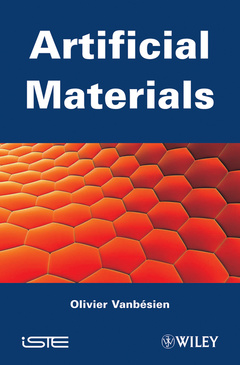Artificial Materials
Auteur : Vanbésien Olivier

This book addresses artificial materials including photonic crystals (PC) and metamaterials (MM).
The first part is devoted to design concepts: negative permeability and permittivity for negative refraction, periodic structures, transformation optics.
The second part concerns PC and MM in stop band regime: from cavities, guides to high impedance surfaces. Abnormal refraction, less than one and negative, in PC and MM are studied in a third part, addressing super-focusing and cloaking.
Applications for telecommunications, lasers and imaging systems are also explored.
Introduction xi
PART 1. A FEW FUNDAMENTAL CONCEPTS 1
Chapter 1. Definitions and Concepts 3
1.1. Effective parameters of materials 3
1.2. Terminology of artificial materials 6
1.3. Negative refraction: stakes and consequences 8
1.4. Bibliography 11
Chapter 2. The Metamaterial Approach – Permeability and Permittivity Engineering 13
2.1. Background history 13
2.2. An imbricated lattice approach 17
2.3. Cell approach 23
2.4. Alternative approach: Mie resonances 31
2.5. Bibliography 33
Chapter 3. Photonic Crystal Approach – Band Gap Engineering 37
3.1. Historical background 37
3.2. Study tool: band structure 39
3.3. 2D ½ photonic crystals 44
3.4. A few words on three-dimensional photonic crystals 53
3.5. Conclusion: metamaterials or photonic crystals? 55
3.6. Bibliography 56
Chapter 4. Transformation Optics 59
4.1. Context 59
4.2. Method description 60
4.3. Bibliography 69
PART 2. MATERIALS USED IN A BAND GAP REGIME 71
Chapter 5. Point and Extended Defects in Photonic Crystals 73
5.1. Context 73
5.2. Defect zoology 74
5.3. Selectivity of photonic crystal microcavities 77
5.4. Waveguiding in photonic crystals 82
5.5. Slowing down light 90
5.6. Bibliography 92
Chapter 6. Routing Devices made from Photonic Crystals 95
6.1. The building brick: the add/drop filter 95
6.2. A few photonic crystal approaches 98
6.3. Interference-based couplers 100
6.4. Conclusion 117
6.5. Bibliography 117
Chapter 7. Single Negative Metamaterials 121
7.1. Context 121
7.2. ENGs: negative permittivity materials 122
7.3. MNGs: negative permeability materials 128
7.4. What of frequency-selective surfaces? 132
7.5. Bibliographyc 135
PART 3. MATERIALS IN AN ABNORMAL REFRACTION REGIME (N < 1 AND N < 0) 137
Chapter 8. Two-dimensional Microwave Balanced Composite Prism 139
8.1. Why use a microwave prism? 139
8.2. Conception and sizing of a balanced composite lattice 140
8.3. Two-dimensional prism 147
8.4. Bibliography 154
Chapter 9. Metal-dielectric Materials – from the Terahertz to the Visible 157
9.1. From the terahertz to the infrared 157
9.2. A backward propagation line at terahertz frequency 158
9.3. From “nano”-resonators to “fishnets” 163
9.4. Three-dimensional metamaterials 172
9.5. Bibliography 174
Chapter 10. Abnormal Refraction in Photonic Crystals 177
10.1. Context 177
10.2. (An)isotropy in photonic crystals 178
10.3. Exploiting anisotropy 185
10.4. Focalization and negative refraction: looking for isotropy 189
10.5. Bibliography 194
Chapter 11. A Photonic Crystal Flat Lens at Optical Wavelength 197
11.1. A bit of background 197
11.2. How to define a typical prototype at optical wavelengths 198
11.3. Lens optimization: impedance and resolution 201
11.4. Experiments 213
11.5. Reverse engineering: from a two-dimensional prototype to three-dimensional reality 218
11.6. Conclusion 221
11.7. Bibliography 222
Chapter 12. Wave-controlling Systems – Towards Bypass and Invisibility 225
12.1. “Transformation optics” or “dispersion engineering” 225
12.2. Component approaches for controlling waves 226
12.3. Invisibility at terahertz frequencies: Mie resonances 241
12.4. An alternative with the photonic crystal: the butterfly 246
12.5. Perspectives 250
12.6. Bibliography 250
PART 4. MOVING TOWARD APPLICATIONS 253
Chapter 13. Guiding, Filtering and Routing Electromagnetic Waves 255
13.1. Context 255
13.2. Guiding: propagation lines and tunable phase shifters 256
13.3. Filtering 266
13.4. Metamaterial-based routing 273
13.5. Conclusion 276
13.6. Bibliography 276
Chapter 14. Antennas 279
14.1. Towards the miniaturization of transmission/reception systems 279
14.2. Directivity engineering 280
14.3. Subwavelength sizing 293
14.4. Conclusion 298
14.5. Bibliography 299
Chapter 15. Optics: Fibers and Cavities 301
15.1. Optical issues: the privileged domain of photonic crystals 301
15.2. Microstructured optical fibers 302
15.3. Toward zero threshold lasers 310
15.4. Bibliography 318
Chapter 16. Detection, Imaging and Tomography Systems 321
16.1. From detection to imaging 321
16.2. Terahertz sensors 322
16.3. Direct approach for imaging 326
16.4. Detection and image reconstruction 328
16.5. A vast field to explore 337
16.6. Bibliography 339
Conclusion 341
Index 345
Olivier VANBéSIEN is Professor, IEMN, at Lille University, France.
Date de parution : 04-2012
Ouvrage de 346 p.
16.3x24.1 cm
Disponible chez l'éditeur (délai d'approvisionnement : 14 jours).
Prix indicatif 206,44 €
Ajouter au panier


